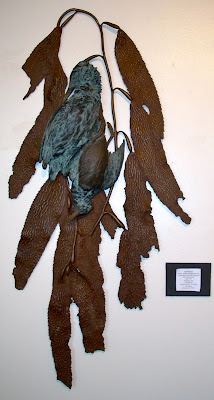 |
| Dead Seabird on Kelp - Peter Bevis, 1990 |
I. One of my most longstanding unfinished music projects dates back to 1993. Seattle bronze sculptor Peter Bevis and I had been putting together what we called the Knik Philharmonic's Second Winter Tour.
In 1992 he had gotten the keys to the freezer vans in the Mountainview neighborhood of Anchorage in which the scores of thousands of carcasses of animals killed and recovered in the Exxon Valdez. Along with writer Philip Schuyler and nuclear sculptor James Acord, we retrieved a number of the dead animals from the semi trailers, took them to the brand new UAA sculpture studios, and under the watchful eyes of Ken Gray and Jeff Patrick, made plaster, rubber and fiberglass molds of them and returned the carcasses to the trailers. Later, after Exxon settled with the Federal government on liability, the carcasses were burnt as toxic waste in an incinerator off of Klatt Road.
Bevis crated and shipped the molds to his foundry in Seattle, where he cast them into bronzes. In early 1993, he shipped the finished sculptures and other road kill art he had created back north.
The Anchorage Daily News' Arts Editor, Thomas Harrison, wrote a long article on the resulting Anchorage exhibit of the bronzes in February 1993, called Road Kills - Spill Kills. The article included color photos for the Sunday Arts section of the paper. Apparently, it isn't available on the web. I wrote music and commissioned Alaska poet Ann Chandonnet to write a poem to accompany the gallery show. The music and poetry were called Shadows.
Along with the bronzes, Peter shipped up about two tons of special casting material for outdoor cold weather winter casting. Our goal was to bring attention to the locally fairly widely-known fact that even though the Alaska Railroad had agreed with the state back in 1991 to begin reporting how many moose it killed along its lines back to state agencies, it had been seriously under-reporting the numbers.
Peter found out through ARR workers I got him in touch with that there were a few places where the ARR was caching unreported carcasses, and that in some places they had just left dozens of dead or dying animals alongside the track close enough to each other that you could see at least ten or so from one place. At the same time, they were hauling back dead animals to Talkeetna or Chase, and claiming those were the total.
We wanted to bust them and publicize it.
The action we pulled off was well done. We had even gotten a letter of permission from the Alaska State Troopers to cast bronzes of dead moose alongside roads and tracks, to raise public safety consciousness. We had further gotten the ARR's head of public relations, Vivian Hamilton, to go along with cooperating with us. We didn't tell her what our bottom line was, though.
In late February 1993, Peter, author Schuyler and Pete's "rapid response roadkill team" descended on the ARR's main illegal carcass cache alongside the tracks about 12 miles outside of Chase. They had chartered several large snowmobiles with trailer sleds to hold the casting materials.
Earlier in the month, Peter had spent time with some of Alaska's top forensic crime investigators, sharing notes on cold weather in situ casting. He had developed a very fast setting, yet durable formula that we had tried outside my house near Wasilla.
He was ready.
The snowmobiles, along with a disaffected ARR worker as guide, descended on the sad scene of about fifteen dead moose discarded in three piles only a couple yards from the railside. After scanning the scene, Pete gave orders and the rapid response team went to work. I couldn't be there, as the Anchorage Symphony's dress rehearsal of my newest work, Fanfare and Capriccio (dedicated to Joe Redington, Sr.) was scheduled for that evening.
About an hour into their work, a train drove by, and the crew could see the engineer on a radio as he passed. In another hour, a bud car came up from Talkeetna, and told them to stop work immediately and leave the scene. Bevis showed them correspondence from ARR publicity flack Hamilton. The ARR crew was befuddled. Eventually, they decided it was too risky to get in trouble by crossing a bigger boss than the one who had sent them there, so they watched in amazement as Bevis and crew hustled along in the deep snow, finished casting, put the molds into prepared plywood boxes, and loaded them onto the equipment.
Bevis asked if the ARR crew wanted to join the rapid response team in Talkeetna for a beer in 90 minutes.
1 comment:
And in the end the love you made is equal to the --beer you gave.
Post a Comment